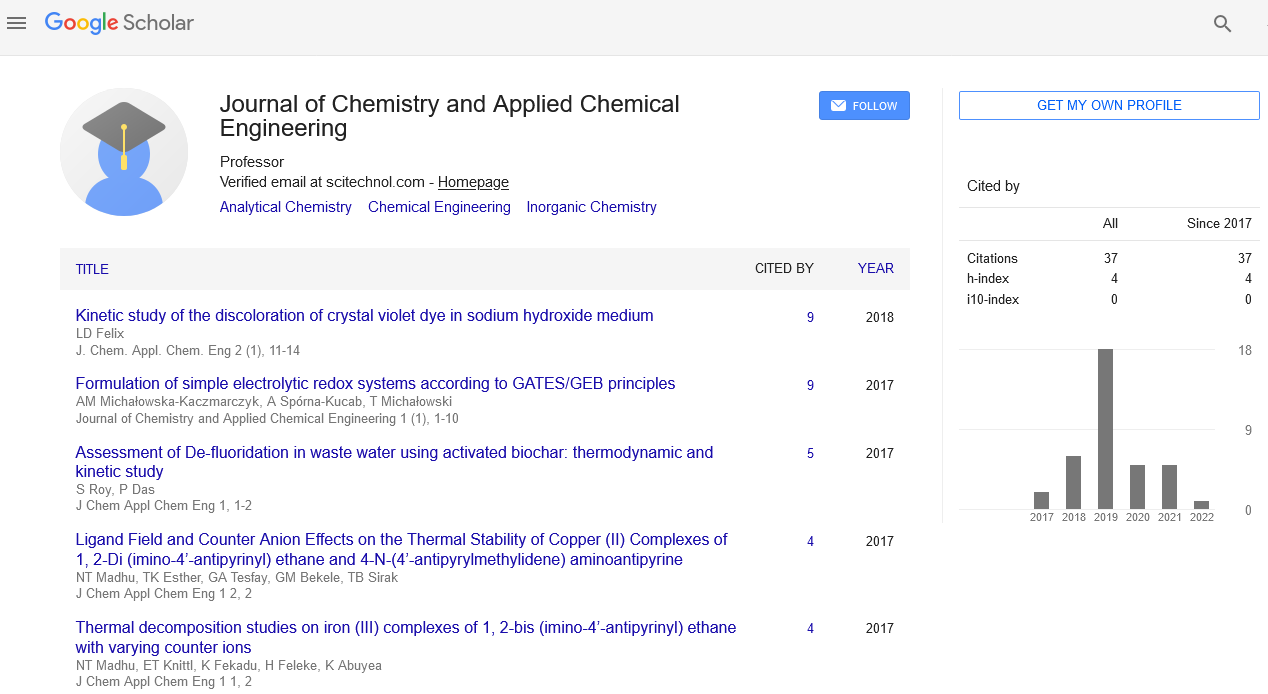Commentary, J Chem Appl Chem Eng Vol: 7 Issue: 2
Transforming Elements into Compounds through Chemical Synthesis
Matthew Hutchinson*
1Department of Chemistry, University of Nottingham, Nottingham, UK
*Corresponding Author: Matthew Hutchinson,
Department of Chemistry,
University of Nottingham, Nottingham, UK
E-mail: hutchinsonmatthew@gmail.com
Received date: 23 May, 2023, Manuscript No. JCACE-23-106830;
Editor assigned date: 25 May, 2023, Pre QC No. JCACE-23-106830 (PQ);
Reviewed date: 08 June, 2023, QC No. JCACE-23-106830;
Revised date: 15 June, 2023, Manuscript No. JCACE-23-106830 (R);
Published date: 22 June, 2023, DOI: 10.4172/Jcace.1000e028
Citation: Hutchinson M (2023) Transforming Elements into Compounds through Chemical Synthesis. J Chem Appl Chem Eng 7:2.
Description
Chemical synthesis is a fundamental branch of chemistry that involves the creation of new compounds through the combination of various chemical reactions. It plays a difficult role in numerous scientific fields, including drug discovery, materials science, agriculture, and environmental science. Chemical synthesis allows chemists to design and construct molecules with specific properties, opening the door to countless applications and advancements in science and technology.
Principles of chemical synthesis
Chemical synthesis is guided by several key principles that dictate the design and execution of reactions:
Atom economy: Atom economy refers to the efficiency of a chemical reaction in utilizing all the atoms present in the starting materials to form the desired product. Reactions with high atom economy are environmentally friendly, as they minimize waste production.
Selectivity: Selectivity in chemical synthesis refers to the ability to produce a specific target compound with minimal unwanted byproducts. Highly selective reactions are essential for pharmaceutical and fine chemical industries, where purity is paramount.
Yield: The yield of a chemical reaction represents the amount of the desired product obtained compared to the amount of starting material used. High-yield reactions are preferred to maximize the efficiency of the synthesis.
Stereochemistry: Stereochemistry deals with the three-dimensional arrangement of atoms in a molecule. The stereochemistry of a product is essential, as different stereoisomers can have vastly different properties and activities.
Methods of chemical synthesis
Chemical synthesis employs a wide range of techniques to produce new compounds. Some common methods include:
• Organic synthesis involves the construction of organic compounds using a variety of reactions, such as coupling reactions, oxidationreduction reactions, and cyclization reactions.
• Inorganic synthesis focuses on the preparation of inorganic compounds, including coordination complexes, metal oxides, and inorganic polymers.
• Combinatorial synthesis is a high-throughput approach that involves the parallel synthesis of a large number of compounds. It is commonly used in drug discovery and materials science.
• Solid-phase synthesis is a technique in which the reactants are attached to a solid support, enabling easier purification and separation of products.
• Green synthesis involves using environmentally friendly and sustainable methods to produce compounds, minimizing the use of hazardous reagents and reducing waste generation.
Applications of chemical synthesis
Chemical synthesis finds diverse applications in various scientific and industrial fields.
• Chemical synthesis is important for designing and producing pharmaceutical drugs, enabling the development of new treatments for diseases.
• Chemical synthesis is used to produce new materials with specific properties, such as polymers, nanomaterials, and catalysts.
• Chemical synthesis is employed to develop new agrochemicals, such as pesticides and fertilizers, to improve crop yields and protect against pests and diseases.
• Chemical synthesis is used to produce materials and compounds for environmental remediation and pollution control.
• Chemical synthesis is utilized in the production of specialty chemicals used in cosmetics, fragrances, and flavorings.
Challenges and future directions
Despite its importance and successes, chemical synthesis also faces challenges:
Complexity: The synthesis of complex molecules can be challenging due to the multi-step nature of the reactions and the need for high selectivity.
Cost and efficiency: Some chemical reactions can be expensive and time-consuming, impacting the scalability of synthesis for largescale production.
Green chemistry: The development of more sustainable and environmentally friendly synthetic methods is an ongoing goal in chemical synthesis.
Automated synthesis: Advancements in automation and robotics are driving the development of automated synthesis platforms, streamlining the synthesis of compounds and increasing efficiency.
Chemical synthesis is a foundational discipline of chemistry that enables the creation of new compounds with diverse properties and functionalities. From drug discovery to materials science, chemical synthesis underpins countless scientific advancements and technological innovations. As researchers continue to develop more efficient and sustainable synthetic methods, chemical synthesis will undoubtedly play an even more significant role in shaping the future of science and technology.
 Spanish
Spanish  Chinese
Chinese  Russian
Russian  German
German  French
French  Japanese
Japanese  Portuguese
Portuguese  Hindi
Hindi 